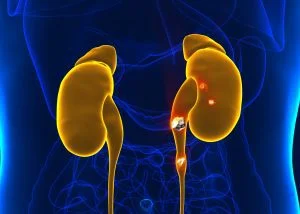Extracorporeal Shock Wave Lithotripsy (ESWL)
What are kidney stones?
Kidney stones are solid pieces of material that form when substances normally found in the urine, such as mineral and acid salts, become concentrated and crystallize.
A stone can range in size from a grain of sand to as large as a golf ball. It may remain in the kidneys or travel down the urinary tract into the ureter. A small stone may pass on its own, causing little or no pain. However, a larger stone may get stuck along the tract and block the flow of urine, resulting in intense pain or bleeding.
Who gets kidney stones?
Anyone can develop a kidney stone, but some people are more likely to get one.
Those with increased risk include:
- Men
- Overweight and obese individuals
- Individuals with a family or personal history of kidney stones
- Dehydrated individuals
- Individuals who maintain diets high in protein, sodium, or sugar.
- Individuals with certain bowel conditions, such as chronic diarrhea and Crohn’s disease, or those who have undergone gastric bypass surgery
- Individuals with other medical conditions including renal tubular acidosis, cystinuria, hyperparathyroidism, certain medications, and some urinary tract infections
Symptoms
Kidney stones do not always cause pain. If they do, the first sign can often be the sudden development of intense, unrelenting, and contraction-like pain in the side and back, below the ribs that spread to the lower abdomen and groin.
Other symptoms may include:
- Nausea and vomiting
- Blood in the urine
- Painful or frequent urination
- Foul-smelling or cloudy urine
- Fever (if an infection is present)
Diagnosis
Tests and procedures to diagnose kidney stones include:
- Detailed family history, lifestyle and dietary habits
- Blood tests
- Urine tests
- Imaging tests
- Analysis of passed stones
What is a Lithotripsy?
A lithotripsy is a medical procedure involved in removing kidney/bladder stones through the use of different processes. Kidney and bladder stones are solid pieces of material that form when substances normally found in the urine, such as minerals and acid salts, become concentrated and crystallized. These stones can grow up to the size of a golf ball. If the stone attempts to exit through the urinary tract, this may lead to immense pain and likely bleeding. Through the lithotripsy procedure, these stones are broken down through the use of laser or shock waves.
Shock Wave Lithotripsy
This is the most common form of removing a kidney or bladder stone. The procedure involves using shockwaves that come from outside of the body. Your Urologist will target the area where the kidney stone is and begin breaking it into smaller pieces. Extracorporeal Shock Wave Lithotripsy is a non-invasive procedure. Once the stones have been broken down into ideally “dust,” then they may travel through the urinary tract. Sometimes the stones may still be slightly too large and further treatment may be required.
Post Extracorporeal Shock Wave Lithotripsy
The effects of lithotripsy sometimes may be painful. You’re likely to see bleeding in your urine and pains in your lower abdomen. The best way to relieve pain is to drink large amounts of water and use some type of oral pain medication. If problems persist for more than a week such as continued bleeding, severe pain, or a strong feeling of needing to urinate, then contact your healthcare provider immediately. Although seldom, these kidney stones may cause bleeding near the kidney, a blockage within your urinary tract, or possibly severe damage where the stone was residing.
Contact a medical professional at Z Urology if you have any of the following symptoms,
- Blood in the urine.
- Painful or frequent urination.
- Foul-smelling or cloudy urine.
- Fever (if an infection is present.)


